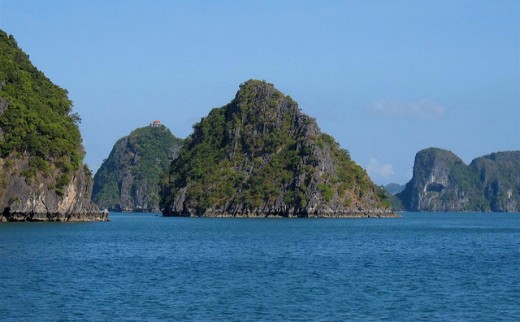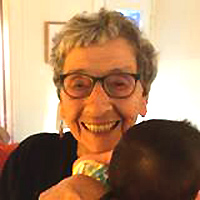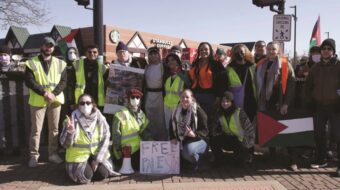
The following are travel diaries by two social justice activists and retired educators on their recent trip to Vietnam. Beatrice Lumpkin is a longtime contributor to the People’s World.
Vietnam, in its struggle to develop its economy, is becoming a tourist paradise. The word is getting out. Tourism revenue increased 40% in 2010.
Pat and I were two of the lucky tourists who took advantage of a last minute price cut. We knew Vietnam would be interesting but we did not expect such lavish good treatment. That included swimming in the South China Sea at a secluded beach and eating fresh sea food scooped out of the sea just minutes earlier.
Few countries are so richly endowed by nature. I can understand why the Vietnamese people fought so heroically to win their independence. The beautiful landscapes include Halong Bay, a UNESCO World Heritage Site. The Bay is such a fantastic sight that when I first saw it in the movie, “Indochine,” I thought it wasn’t real. It looked like an imaginary movie location. Over 3,000 rugged hills were carved by the rain to form sinkholes, caves, and sinking streams. What makes Halong Bay unique is that the sea invaded the hills, making for fantastic marine beauty and rich fishing sites.
Vietnam is 1,000 miles long. The eastern side of the country has beautiful beaches, stunning ocean bays and productive fishing villages. The western length of the country runs across mountains glowing with a soft green covering. Still the realities of their wars for independence are barely beneath the surface.
The mountains and hills are green but many are covered with eucalyptus trees, planted in a hurry. The hills used to be covered by centuries-old mahogany and other slow-growing valuable trees. These magnificent trees all died after the U.S. military sprayed them with Agent Orange during the Vietnam War. To save the little soil left, the Vietnamese planted the fast-growing, softwood eucalyptus. But they still mourn the loss of their splendid forests.
The people of Vietnam are warm and welcoming. Their high moral values are shown in their love for “Uncle Ho,” their national hero. Ho Chi Minh is respected for his modesty, simple life style and wise leadership.
Education and university students
One of the most enjoyable afternoons of our Vietnam trip was at the University of Dalat in an interchange with students. Students were eager to practice English conversation. They were also curious about the visitors from the United States and we were interested in them.
A professor alerted us to the problems they are facing. The future of the country depends on raising the technical and scientific level of the economy. But there is a shortage of qualified science and mathematics teachers. Teachers are respected and, as in all countries, they work very hard. In addition to their classes, many teachers do private tutoring to supplement their wages.
Education is a priority of the Socialist Republic of Vietnam. Despite very limited resources, they have achieved a 94% literacy rate. Even in remote mountain hamlets, the children are guaranteed free primary education. They are working on making junior high school universal.
A major need is to improve the qualifications of teachers at all levels. We decided to visit the Center for International Education Culture Exchange and Research Center and learn more. They gave us an immediate appointment with their deputy director, Huynh Xuan Nhut.
Mr. Nhut said his Institute’s goal for 2011 was to improve the use of assessment standards both for high school and universities. Teachers enjoy free summer courses to improve their methods of teaching and deepen their knowledge of their subjects. Education is respected. University admission is very competitive. Parents pay for private tutoring to improve their children’s academic ranking. About 75% of the population are farmers. For farmers’ children especially, high grades are the route to higher education and better jobs.
Development
We were not surprised to learn that Vietnam is a large exporter of rice, second only to China. The Red River and Mekong deltas are very fertile with at least three crops a year in the South. But we were surprised to learn that Vietnam exports more coffee than any other country except Brazil. We can vouch for the excellence of Vietnam coffee, especially “weasel” coffee. It’s not really from a weasel but a palm civet cat that partly digests the coffee beans. Of course, it is very carefully washed and makes a rich, much sought-after drink.
But a country cannot develop its economy on an agricultural basis alone. Industry, especially high tech industry is needed. While the wealth of Vietnam is increasing, it is still a poor country. It does not have the capital to develop on its own. After the US normalized relations with Vietnam in 1995, Vietnam opened up to foreign investment. The American, Taiwanese, European and other investors came in with the idea of paying as low wages as they could get away with. Over 7,000 companies have not even paid their social insurance tax. This tax pays for health care and other social services the people need, Vietnam is now suing the worst offenders. Nor is it surprising that there has been a wave of strikes for higher pay, better food and earlier Tet vacations. Given the history, Vietnamese workers are sure to succeed in raising the low pay scales up to a living wage.
Have they recovered?
Friends ask, “Has Vietnam recovered from the war?” The answer is, “Yes and no.” The country is now enjoying peace after hundreds of years of wars for independence. That peace is highly valued and most of the war damage has been cleared away.
But as we write these lines, there are Vietnamese children and adults being blown up by land mines and other munitions that still litter the countryside. Whole families earn their living by digging up unexploded bombs to sell the metal. Sometimes the bombs go off and there are casualties. And the loss of millions who died during the war is still keenly felt.
Our trip included a visit to the War Remnants Museum in a state-of-the-art building. Hardest to look at are the photographs of the children born deformed by Agent Orange. In the hall of Historical Truths, one of our tour members told us, “I am so ashamed. I didn’t know that Ho Chi Minh was leading the whole country so far back.” She was looking at the “historical truth” of 1945 when Ho read the Declaration of Independence of the Democratic Republic of Vietnam. The exhibit also showed the Geneva Accord of 1954 that called for nationwide elections in 1956 throughout Vietnam. But the United States did not allow the elections to take place.
The most peaceful hall was the “dove,” the children’s education room.” It was lit up with children’s paintings asking is for peace. The hall on the “world’s people in support of Vietnam’s resistance,” was interesting. I would have like to have seen more photos of anti-war demonstrations in the U.S. Perhaps some of our great photographers would like to donate a photo to the War Remnants Museum in Ho Chi Minh City.
– Beatrice Lumpkin
Beautiful country, beautiful people
Every country has a rich cultural heritage and natural beauty, yet Vietnam seems especially endowed. The beauty of nature and its landscape in Vietnam are breathtaking and guaranteed to relax and rejuvenate. But what made the trip to Vietnam a truly treasured experience was the Vietnamese people.
The insight began with Beatrice. This was her second trip to Vietnam and her most convincing point for our making the trip was that “…the people are wonderful!”
Our connections with the Vietnamese people came easily and quickly. Why was this so? From our first day and travels throughout the country, we received warm welcomes from all of the folks we met. The hospitality of people “on the street” was quite remarkable. We noted that almost every time one of us exchanged a glance with a stranger, an instantaneous nod of acknowledgement was directed our way, often followed by a gentle smile-communicating quite clearly “you are welcome among us.”
Was it the demonstrations of respect and kindness we received and observed around us, constantly? Was it the people’s devotion to family, reverence of ancestors and cultural traditions, great respect for teachers and belief in education as the best promise for a good future?
Was it the countless expressions of creativity and style, and what can only be described as the Vietnamese people’s extreme attention to detail? Was it the richness of styles and colors, the delicateness of textures, tastes, fragrances-all complimenting each other, so carefully put together-that delighted our senses so unrelentingly?
So many lasting impressions-the gorgeous flowers and delicious food, beautifully woven tapestries and graceful “ao dai” (women’s fitted tunic worn over pants), the exquisite presentation of just about everything, evidenced everywhere: outdoor markets, tourist hotels, historic buildings, monuments, temples and pagodas, private residences, public parks and gardens, even roadside alters.
Constantly and delightfully caught off guard with so many lovely, unexpected jewels, we can never forget- the 3,000 islands of Ha Long Bay; the orchids on the tables at the tiny diner in Dalat; gorgeous Hibiscus blossoms among stacked towels for rent at the beach; and the sunrise sight of hundreds of young women across the country cycling to high school, heads high and backs straight in beautiful flowing ao dai uniforms.
So many memorable experiences of our visit with the people of Vietnam, but nothing stands out more than what we heard from young and old throughout the country, time and time again-the Vietnamese people’s pride in their country and their national unity, and their hopes for the future and peace among all peoples in the world.
– Patricia Flagg Poole
Photo: One of the beautiful scenes of Halong Bay, Vietnam. (CC)

MOST POPULAR TODAY

High Court essentially bans demonstrations, freedom of assembly in Deep South

Zionist organizations leading campaign to stop ceasefire resolutions in D.C. area

U.S. imperialism’s ‘ironclad’ support for Israel increases fascist danger at home

UN warns that Israel is still blocking humanitarian aid to Gaza








Comments